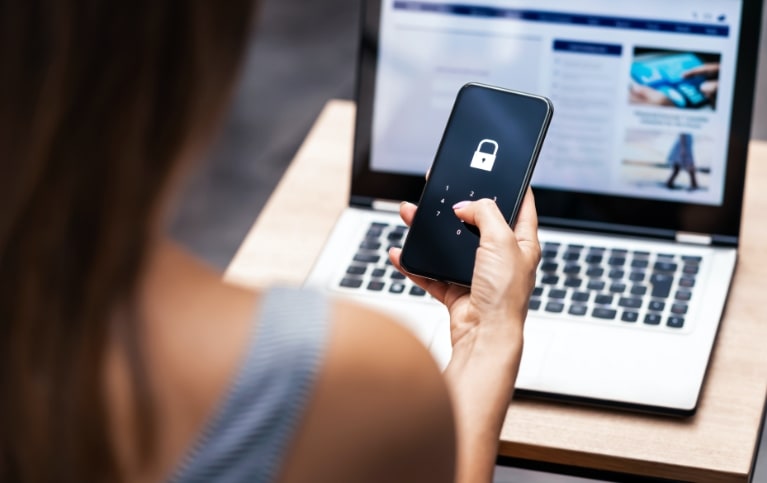Smartphones play a vital role in our daily lives. They’re not only efficient communication devices, but they also come with virtual assistants, photo and video capabilities, web browsing, and a host of other features rolled into one palm-sized computer. Since smartphones are so versatile that people often store a lot of business and personal information in these devices.
However, smartphones’ widespread popularity and capacity to hold a treasure trove of sensitive information make them high value targets for cybercriminals. In fact, just this year alone, cybersecurity provider Kaspersky detected over 29 million mobile threats, which include malware like banking Trojans, adware, and ransomware. What’s even worse is that many people leave their phones unprotected, giving hackers an easy way into classified data and corporate systems.
To safeguard your phone and its contents, you must develop a well-rounded security strategy and adopt proper safety precautions. Here are some tips on how to protect your phone from being hacked.
1. Lock your smartphone
The most basic step in securing your device is to lock it with a passcode, pattern, fingerprint scan, or facial recognition. It’s also a good idea to shorten the time at which your device locks on its own after a period of inactivity. This way, if someone gets a hold of your phone, they won’t be able to access your emails, apps, and sensitive data. Hackers can try to guess your phone’s passcode or pattern, but the device will automatically disable for a period of time after a series of failed attempts.
2. Avoid public Wi-Fi networks
Public Wi-Fi networks like the ones found in cafes, airports, and hotels may help you save on mobile data, but they’re home to all sorts of cybercriminal activity. Hackers often intercept communications across public networks to steal sensitive data such as passwords and financial information. Other cybercriminals may even create trap Wi-Fi networks to lure unwitting users and spread malware to their devices.
The best defense against public Wi-Fi networks is to avoid them altogether. Instead, use 4G or 5G networks to connect to the internet, as these encrypt data you transmit from your phone. However, if connecting to public Wi-Fi is the only option, use a virtual private network (VPN). A VPN essentially encrypts your internet traffic and masks your IP address, making it more difficult for cybercriminals to track your online activities and steal data.
| Related reading: Learn how to work securely when working remotely |
3. Update your apps and operating system (OS)
Software developers release updates when they uncover bugs and security flaws in their products. Updating your phone’s software regularly is therefore crucial in patching any vulnerabilities that cybercriminals can exploit.
Keep in mind that Apple and Android don’t just provide major OS updates every year to offer new features; you also need to stay on top of incremental updates that offer critical security fixes. Alternatively, you can set up your device to automatically install app and OS updates to keep everything safe. You’ll also need to uninstall any apps you no longer use because they can become potential security problems when neglected.
4. Use official app stores
When downloading apps, make sure they come from official app stores like the Apple App Store and Google Play. This is because official app stores set strict development guidelines for programmers and thoroughly vet applications for any traces of malware. In contrast, third-party app stores are not rigorously regulated, so there’s a higher chance of finding fake versions of an app or malware-laced programs in them.
Another important precaution is to assess the app for yourself. If an app barely has any positive reviews and installs, it may be better to go with a more popular alternative. You should also check when the app was last updated to see whether the developer is proactively fixing and securing their product.
5. Manage app permissions
The apps on your phone should only have the minimum permissions necessary to function. Some apps may require access to your phone’s camera or microphone, while others may need access to location services and storage. The problem is certain apps may be overstepping their boundaries with data collection and phone functionalities.
That’s why it’s worth auditing your app permissions and revoking access wherever possible to protect your privacy, especially if the software developer has recently suffered a data breach. For iPhone users, go to Settings > Privacy to see the permissions you’ve granted to each app. If you have an Android device, go to Settings > Apps & notifications > Advanced > App permissions — note that these menus may vary depending on the device manufacturer.
6. Don’t jailbreak or root your device
Jailbreaking or rooting is the process of removing restrictions imposed by device manufacturers so users can install alternative apps and features. However, removing these restrictions also disables the built-in safeguards that come with your iPhone or Android phone, increasing your exposure to cyberattacks. To make matters worse, jailbreaking or rooting voids your warranty, which means Apple or Android won’t support you or provide security patches if your device is compromised.
7. Implement mobile device management (MDM)
MDM software enables you to oversee and protect company-registered phones from a central console. With top MDM solutions like Microsoft Intune, you can distribute software updates across multiple devices, block unsanctioned applications, and remotely troubleshoot security issues on your phone.
What’s more, in case you lose your phone, MDM software can track it in real time using GPS technology. The software can even remotely wipe your phone to prevent sensitive information from falling into the wrong hands.
8. Back up your data
Backing up your data in a secure offsite server or the cloud offers several advantages. For one, backups ensure you still have access to your data if your phone is ever lost or stolen and you need to remotely wipe its contents. Secondly, data backup solutions make the process of transitioning to a new phone fairly straightforward. All you need to do is restore your backup files onto a fresh device.
The bottom line is that your business needs to be proactive with its cybersecurity strategies to keep up with the constantly evolving mobile threat landscape. If you need advanced security solutions and professional advice for managing mobile security, Dynamic Solutions Group can help. Call us today to protect your smartphone.






